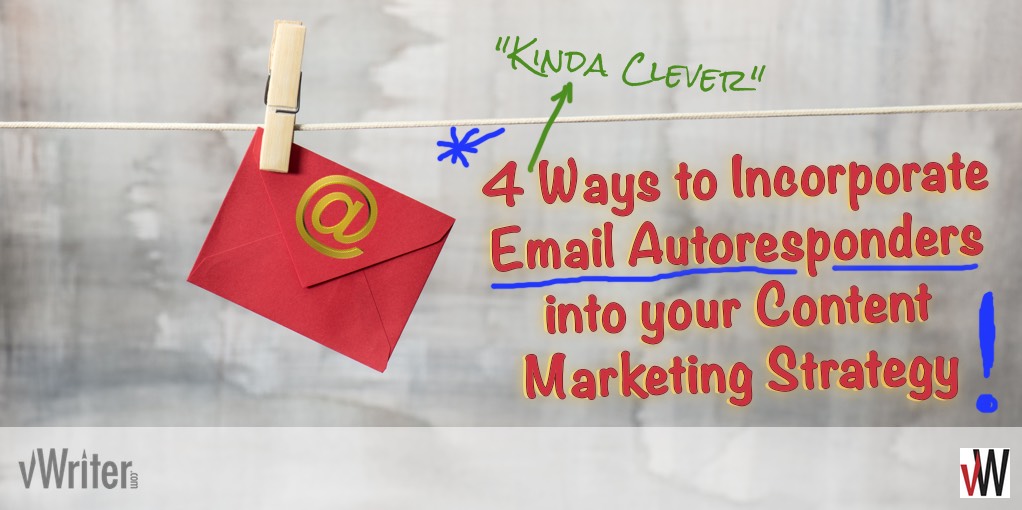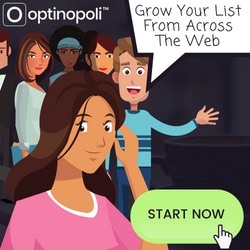But are you using autoresponders as a purposeful part of your content marketing strategy?
Sure, you’re taking the time to:
- Write and deliver great blog content
- Cultivate and schedule your social media posts
- Email your audience to communicate with them more directly.
But each of these options takes time, effort, and creativity, and often every single day.
 Autoresponders can be used to both lighten the load and better leverage all the content you have to increase your results.
Autoresponders can be used to both lighten the load and better leverage all the content you have to increase your results.
They mean you can be delivering great content to your subscribers every day, even on days when you’re not feeling particularly creative. They help you:
- Build your relationship with your audience and make that relationship more valuable for your business
- Expand your audience so you’re able to share your message with more people and reach more of your marketplace.
After quickly running through exactly what an autoresponder is in case you’re unsure, I’ll then show you some different, if-I-might-say-so “kinda clever” ways autoresponders can work within your content marketing strategy to help grow your business.
What Are Autoresponders?
At their simplest level, autoresponders, sometimes referred to as “drip campaigns”, are targeted emails that are sent to a subscriber after being triggered on a specific date, by an event, or by a contact’s activity.
They also allow you to create a series of emails that are sent to your subscribers at set intervals after they join your list. This allows you to create an automatic follow-up series of emails for new subscribers.

Email marketing services that allow you to use autoresponders include Aweber, MailChimp, and GetResponse.
These, and other services, make it super easy to create and manage a series of autoresponder emails. You can also have multiple lists within your account where subscribers receive a different set of emails depending on which list they join.
What’s so Different with Autoresponders Compared with Traditional Emails?
Traditional emails sent to your list are generally a once-only “broadcast” approach. You spend time writing, designing, and compiling the content in the email and broadcast to your list of subscribers either immediately or at a scheduled date and time. The same email won’t be sent again.
These broadcast, once-only emails work well for say sharing your latest content, general updates, letting your list know about upcoming events that might interest them, running one-off promotions, and so on.
While broadcast emails are a key part of any email marketing — and indeed, content marketing — strategy, autoresponders give you more leverage.
You only have to create the email and any related content once and you can then use it repeatedly, sending it out based on whatever trigger or time sequence you’ve set it for.
For content marketing purposes, when used correctly, autoresponders allow you to automate a portion of your content marketing strategy.
This makes your strategy more efficient, with less time investment, and frees you up to tackle other things, including the creation of additional content or other marketing to help grow your business.

4 “Kinda Clever” Ways to Use Autoresponders for Content Marketing
 Welcome Series
Welcome Series
A lot of business owners set up a new list on an autoresponder, and only set up a single email when someone first subscribes. That’s a waste.
Sure, you want to initially welcome someone to your list and your business. But that relationship is only built through continued follow-up.
A carefully crafted set of initial emails can really help to build that relationship.
Start by sharing:
- Your expertise
- Information about your business
- Other ways the subscriber can connect with you.

For example, you might design a “Welcome Series” of emails, where as soon as someone signs up, they get a sequence of emails that might look a bit like this:
- An initial email welcoming them to your list.
- An email the following day, reminding them who you are, what your business does, and inviting them to connect with you and your business on social media.
- After a couple days or so, an email containing some useful information you know will be valuable to them. This could be a brief intro with a link to some content you’ve written somewhere, a useful video, or perhaps a downloadable report.
- After another two or three days, an email containing one of your most useful, standalone tips. Again, remind them to connect with your business on social media, perhaps via a quick note at the end or in a P.S..
- And so on…
Ideally, you’re looking to just begin that relationship with your subscriber. You’re introducing your audience to you, your business, and the type of content you share.
You’re engaging with them as soon as they join your list, drawing them into your community and inviting them to connect through other channels.
You might even consider making them a limited time offer on something really valuable which you normally charge a lot more for, just as a further introduction to you and your business.

There’s no standard time frame or set number of emails for a series like this. You could send daily for a week, or weekly for a year! Discover what works best for your business and your audience.
Your autoresponder series should help new subscribers to get familiar with your content style, while encouraging them to respond and interact with you.
However, be consistent in your style and the type of content you send, otherwise you’ll damage the relationship you’ve worked hard to build.
The aim is to get your subscribers to enjoy reading your emails and to look forward to hearing from you again.
 Highlight Your Best Content
Highlight Your Best Content
Someone new to your community is very unlikely to spend hours going back through and reading every blog post you’ve ever written along with other content you have published around the web.
Yet no doubt you’ve got lots of valuable information in that content your new subscriber would benefit from.

So, how do you help them find and take advantage of your best content?
Set up an autoresponder series!
Most autoresponder services allow you to add new subscribers to more than one autoresponse sequence when they first sign up.
So why not set up a specific autoresponder sequence that sends out a link to your best content every week or so for several weeks?
Review it every few months to keep it fresh. Add new content to the end of the sequence and/or use to replace existing content that might have got a bit tired or less relevant.

Link to Your Content Across the Web
Don’t just link back to your own blog, but also to your content on other content platforms too.
By doing so, you:
- Help that content rank by building engagement with it
- Attract more of your audience to it, and thereby to your business
- Encourage higher levels of social sharing
- Grow your authority and influence
- Help grow your audience on those platforms, and build another traffic channel for your business.
Think about sharing:
- Videos you’ve created and published on YouTube
- SlideShare presentations
- Content you’ve contributed on Medium, or on a Quora blog
For example, here’s a SlideShare presentation I created that has so far attracted several thousand views, partly thanks to this type of technique:
Also, share guest posts you’ve contributed to other blogs. This can help to:
- Build your authority in the mind of your subscribers
- Grow your status as an expert in your niche and/or a leading business in your industry
- Attract guest posting opportunities by simply stating you’ll be sharing the content with your list on an ongoing basis.
By using an autoresponder as a key part of your content marketing strategy, you’ll have effectively automated ongoing, continuous traffic to your blog and other content with little or no ongoing effort, while helping to build a valuable audience for your business who come to know, like and trust you.
 An Email Training Series
An Email Training Series
An extension of the technique above is to repurpose several blog posts on a particular topic, and create an exciting email training series that allows subscribers to access your content in new ways.
You can also use the series to attract new subscribers onto your list.
Drive traffic back to your blog and to your content on other platforms by adding links to related, interesting, or popular content within each email.
Think about the type of content you’ve created so far and write down two or three possibilities that already exist in your business.
Or what type of content could you plan to create in future that would allow you to take advantage of this?

The most effective training courses satisfy an informational need from your audience. The focus is on teaching your audience something, by sharing information through text, video and sometimes other types of information such as info-graphics.
If the information is valuable, your audience will engage, and it helps you build a strong relationship with them.
It doesn’t have to be long, extensive and take weeks to create.
A shorter “bite-sized” training course is easier to put together, and can be more appealing to new subscribers who may not want to commit to something more in-depth until you’ve built more of a relationship with them.
However, longer series work too.
A longer training series is an opportunity to dive deeper into a new or previously covered topic. By engaging with your subscribers over a longer period of time, you build more of a rapport with them.
You could also seek to monetize a longer training series by offering it on a paid-access only basis, and perhaps linking to further online resources specifically for your paid subscribers.

 Dive Deep with Exclusive Content
Dive Deep with Exclusive Content
Is there a topic you have particular, specialised expertise about?
Use this knowledge to jumpstart an autoresponder series containing content you haven’t shared elsewhere, exclusive to your autoresponder subscribers.
Think about the topic or skill you are knowledgeable about and how you could best deliver that expertise to your audience.
For example, it could be:
- A series of face-to-camera videos delivered with a personal feel, and/or screen-sharing demonstration videos. Each email in the series would share the next video in the sequence.
- Downloadable reports and other information. For example, each email could deliver a downloadable, printable sheet containing the valuable information you want to share. Encourage your subscribers to collect all the sheets in the series so they get the full benefit of your expertise.
- A membership site that drip feeds information over a certain period of time depending on when the user signed up. Each email can alert them to the new content becoming available to them.
Build more of a rapport with your audience by not just focusing on the tips and takeaways, but also sharing stories of when things went wrong, the mistakes you made along the way, the lessons you learned and how you adapted to become successful.
This is what can help people really engage with you, build a connection, and see a path for themselves from their current position to the success you’ve achieved.
Share PDFs, worksheets, or templates to help your readers find their own version of success.
![]()
To Conclude
As you can see, there are multiple ways to incorporate email autoresponders into your content marketing strategy, delivering various benefits for your business. You might even find the odd one or two ideas “kinda clever”, and think they could work for you.
Take a look back through the list above and pick just one idea to start putting into action today.
Sure, setting up an autoresponder series may take a bit of time on the front end. But it’s an investment from which you’ll enjoy the rewards for your business for years to come.
As new subscribers join your list, by having one or more of the ideas above in place, you’ll be engaging and building your relationship with your audience on a deeper level, while making your business more profitable for the long term.




